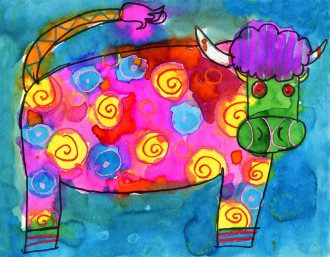28th July 2016
By April McCarthy
Guest writer for Wake Up World
Whether you’re Van Gogh or a stick-figure sketcher, a new Drexel University study found that making art can significantly reduce stress-related hormones in your body.
Although the researchers from Drexel’s College of Nursing and Health Professions believed that past experience in creating art might amplify the activity’s stress-reducing effects, their study found that everyone seems to benefit equally.
“It was surprising and it also wasn’t,” said Girija Kaimal, EdD, assistant professor of creative arts therapies. “It wasn’t surprising because that’s the core idea in art therapy: Everyone is creative and can be expressive in the visual arts when working in a supportive setting. That said, I did expect that perhaps the effects would be stronger for those with prior experience.”
[pro_ad_display_adzone id=”110028″]
The results of the study were published in Art Therapy under the title “Reduction of Cortisol Levels and Participants’ Responses Following Art Making.” Kendra Ray, a doctoral student under Kaimal, and Juan Muniz, PhD, an assistant teaching professor in the Department of Nutrition Sciences, served as co-authors.
“Biomarkers” are biological indicators (like hormones) that can be used to measure conditions in the body, such as stress. Cortisol was one such the hormone measured in the study through saliva samples. The higher a person’s cortisol level, the more stressed a person is likely to be.
For Kaimal’s study, 39 adults, ranging from 18 to 59 years old, were invited to participate in 45 minutes of art-making. Cortisol levels were taken before and after the art-making period.
Materials available to the participants included markers and paper, modeling clay and collage materials. There were no directions given and every participant could use any of the materials they chose to create any work of art they desired. An art therapist was present during the activity to help if the participant requested any.
Of those who took part in the study, just under half reported that they had limited experience in making art.
The researchers found that 75 percent of the participants’ cortisol levels lowered during their 45 minutes of making art. And while there was some variation in how much cortisol levels lowered, there was no correlation between past art experiences and lower levels.
Written testimonies of their experiences afterward revealed how the participants felt about the creating art. “It was very relaxing,” one wrote. “After about five minutes, I felt less anxious. I was able to obsess less about things that I had not done or need [ed] to get done. Doing art allowed me to put things into perspective.”
However, roughly 25 percent of the participants actually registered higher levels of cortisol — though that wasn’t necessarily a bad thing.
“Some amount of cortisol is essential for functioning,” Kaimal explained. “For example, our cortisol levels vary throughout the day — levels are highest in the morning because that gives us an energy boost to us going at the start of the day. It could’ve been that the art-making resulted in a state of arousal and/or engagement in the study’s participants.”
[pro_ad_display_adzone id=”110028″]
Kaimal and her team believed, going into the study, that the type of art materials used by participants might affect cortisol levels. They thought that the less-structured mediums — using clay or drawing with markers — would result in lower cortisol levels than the structured — collaging. That, however, wasn’t supported by the results, as no significant correlation was found.
The study did find a weak correlation between age and lower cortisol levels. Younger participants exhibited consistently lower cortisol levels after they’d created art.
Those results made Kaimal wonder about how young college students and high school students deal with the stress that comes from academia — and how creative arts can help.
“I think one reason might be that younger people are developmentally still figuring out ways to deal with stress and challenges, while older individuals — just from having lived life and being older — might have more strategies to problem-solve and manage stress more effectively,” Kaimal said.
In light of that, Kaimal plans to extend the study to explore whether “creative self- expression in a therapeutic environment can help reduce stress.” In that study, other biomarkers like alpha amylase and oxytocin will also be measured to give a more comprehensive picture.
Additionally, Kaimal also plans to study how visual arts-based expression affects end-of-life patients and their caregivers.
“We want to ultimately examine how creative pursuits could help with psychological well-being and, therefore, physiological health, as well,” she said.
Recommended articles by April McCarthy:
- Scientists Link Processed Foods to Autoimmune Disease
- Drinking 3 Litres of Water Per Day Made This Woman Look Ten Years Younger
- 93 Percent of Ayurvedic Medicinal Plants Are Now Facing Extinction
- Do You Have a Sleep Disorder? Discover The Best Foods to Promote Sleep
- Plants Are Far More Intelligent Than We Ever Assumed
- The Secrets of Food Marketing and How You’re Being Fooled By Advertising
- Scientists Find That The Human Body Kills Spontaneous Cancers Daily
- Forget Fluoride! Make Your Own Toothpaste with These 3 Easy Recipes
- Mobile Phone Use in Children and Teens Translates to 5 Times Increase in Brain Cancer Rates
- 14 Things People Probably Do Not Want To Know About Their Favorite Foods
- 15 Effective Foods For Mood and Happiness
About the author:
April McCarthy is a community journalist playing an active role reporting and analyzing world events to advance our health and eco-friendly initiatives.
This article originally appeared on PreventDisease.com, reproduced by permission.
[pro_ad_display_adzone id=”110027″]







